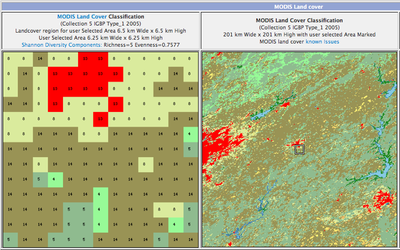Difference between revisions of "Climate and Land Use Research"
| Line 1: | Line 1: | ||
| + | [[File:Athens LC V5.png|thumb|400px|right|MODIS Land Cover GA003 Athens, Georgia, USA]] | ||
Plant/pollinator interaction is used to measure the performance of the environment, instead of the performance of individual hives. Since the 1970's NASA volunteers have been measuring plant/pollinator interaction to help correlate satellite imagery with what is happening on the ground. | Plant/pollinator interaction is used to measure the performance of the environment, instead of the performance of individual hives. Since the 1970's NASA volunteers have been measuring plant/pollinator interaction to help correlate satellite imagery with what is happening on the ground. | ||
| Line 4: | Line 5: | ||
At [http://honeybeenet.gsfc.nasa.gov/ NASA's Honey Bee Net] the data is carefully checked for accuracy and assigned a quality score. NASA's data from Maryland indicates that the peak nectar flow occurs nearly 4 weeks earlier than in 1970's. | At [http://honeybeenet.gsfc.nasa.gov/ NASA's Honey Bee Net] the data is carefully checked for accuracy and assigned a quality score. NASA's data from Maryland indicates that the peak nectar flow occurs nearly 4 weeks earlier than in 1970's. | ||
| − | |||
| − | |||
Revision as of 07:51, 19 April 2015
Plant/pollinator interaction is used to measure the performance of the environment, instead of the performance of individual hives. Since the 1970's NASA volunteers have been measuring plant/pollinator interaction to help correlate satellite imagery with what is happening on the ground.
Hivetool's Data Download program allows easy downloads in NASA's data format.
At NASA's Honey Bee Net the data is carefully checked for accuracy and assigned a quality score. NASA's data from Maryland indicates that the peak nectar flow occurs nearly 4 weeks earlier than in 1970's.
